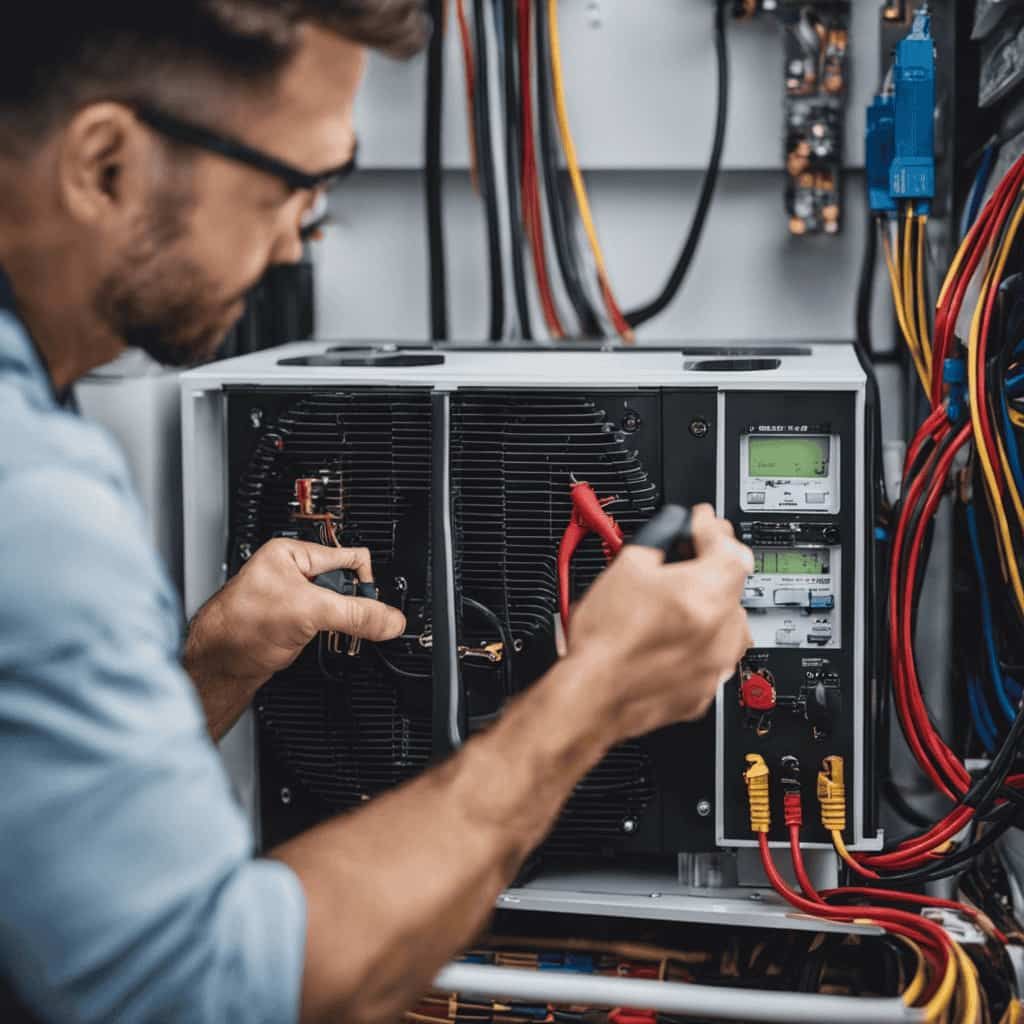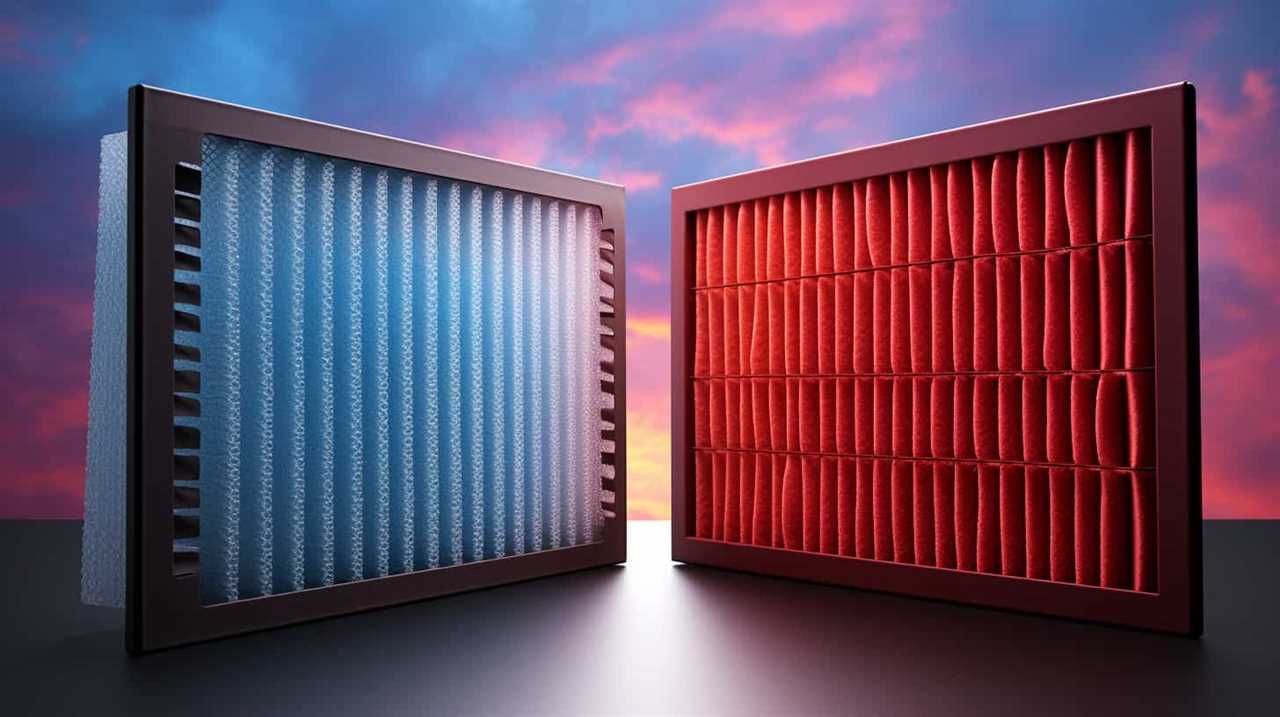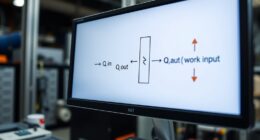Integrating heat pumps with thermal storage boosts energy efficiency by capturing excess heat during low-demand periods for later use. Using materials like phase change materials (PCMs), these systems store and release heat at ideal temperatures, reducing energy waste. Smart controls and advanced technologies further improve performance, making your heating and cooling more sustainable and cost-effective. If you continue exploring, you’ll discover how recent innovations can enhance your system even more.
Key Takeaways
- Integrating thermal storage with heat pumps allows excess heat to be stored during low-demand periods for later use.
- Phase change materials (PCMs) enhance storage capacity by storing latent heat at constant temperatures, improving efficiency.
- Smart control systems optimize energy flow between heat pumps and storage, increasing system COP by adjusting to demand and environmental conditions.
- Thermal storage reduces cycling and peak load, enabling heat pumps to operate more efficiently and sustainably.
- Advanced integration techniques, such as cascade systems and hybrid storage, enhance performance and support renewable energy utilization.
The Fundamentals of Heat Pump Operations and Thermal Storage Systems
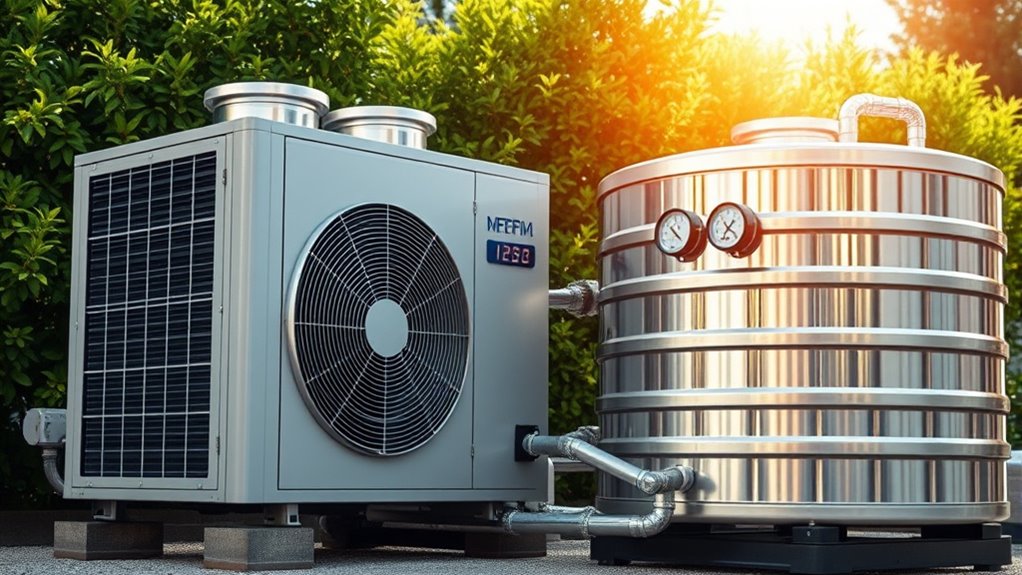
Heat pumps operate by transferring thermal energy from a colder source, such as the outside air or ground, to a warmer indoor space through a refrigeration cycle that includes evaporation, compression, condensation, and expansion. They are highly adaptable and can work efficiently with thermal storage systems, like phase change materials (PCMs), to optimize energy use. Thermal storage allows you to store excess heat during low-demand periods and release it when needed, boosting overall efficiency. PCMs are especially effective because they store latent heat at nearly constant temperatures, increasing the energy density of thermal storage. Integrating heat pumps with thermal energy storage enhances energy efficiency by reducing cycling and peak loads, ensuring a more consistent and cost-effective indoor climate control system. Additionally, understanding the tuning process of these systems can help optimize their performance and lifespan. Proper storage techniques can further improve system operation by maintaining optimal conditions and preventing heat loss. Employing data-driven strategies can also identify opportunities for efficiency improvements and system optimization.
Recent Advances in Integrating Heat Pumps With Thermal Storage
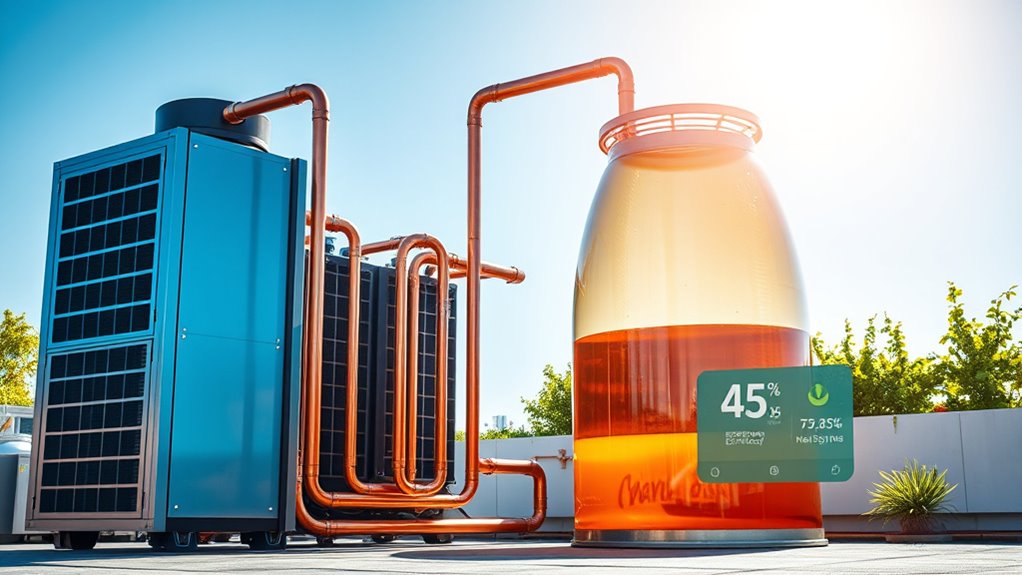
Recent advances focus on innovative storage technologies, like phase change materials, that boost heat pump efficiency and reduce system size. You’ll see new integration methods, such as PCM-enhanced desuperheaters and cascade systems, that improve performance and frost management. These developments also include smart control systems that optimize energy use based on load and environmental conditions. Additionally, research into thermal energy storage systems highlights their potential to further enhance overall system performance and sustainability. Incorporating renewable energy integration strategies can also help maximize the benefits of these advanced systems. Furthermore, understanding the system optimization techniques is essential for designing more efficient and adaptable thermal storage solutions. Advances in system components are also paving the way for more resilient and scalable heat pump systems, ensuring better integration with existing infrastructure.
Innovative Storage Technologies
Innovative storage technologies are transforming how heat pump systems manage thermal energy, with recent advances focusing on high energy density, low-cost phase change materials (PCMs). These materials improve thermal storage by absorbing and releasing heat efficiently, supporting better system integration. Smart control systems optimize PCM energy storage and release, adapting to consumption patterns and environmental conditions. Technologies like Sunamp’s Thermino ePlus PCM units offer compact, high-performance options with minimal heat loss, ideal for space-constrained residential setups. Researchers are exploring natural refrigerants like R290 combined with PCM storage to enhance system sustainability. Additionally, advancements in thermal storage capacity enable seamless coupling of heat pumps with thermal buffers, reducing defrosting cycles, managing loads effectively, and boosting overall energy efficiency.
Performance Optimization Strategies
How can integrating advanced control algorithms with thermal energy storage enhance heat pump efficiency? By optimizing thermal management and storage charging/discharging cycles, smart algorithms improve overall performance. Recent advances show that combining phase change materials (PCMs) with thermal storage systems boosts heat pump efficiency, increasing COP by around 27%. High energy density, low-cost PCM storage like Sunamp’s Thermino ePlus enables compact thermal buffering, supporting performance optimization. Reverse-cycle hot gas defrosting combined with thermal energy storage reduces frost formation and defrost times, especially in cold climates. These strategies help manage peak loads and facilitate renewable energy use. Additionally, the integration of AI-driven control systems with thermal storage allows for more precise regulation of energy flow, further enhancing efficiency. Incorporating compact and portable thermal storage solutions can also facilitate flexible deployment in various settings. Optimizing thermal management through these integrated strategies maximizes system efficiency, reduces energy consumption, and enhances thermal regulation for better overall system performance. Understanding the Refrigeration cycle plays a crucial role in effectively implementing these advanced systems. Moreover, leveraging innovative heat transfer techniques can further improve the responsiveness and effectiveness of thermal storage systems.
Key Benefits of Combining Heat Pumps and Thermal Storage for Energy Efficiency
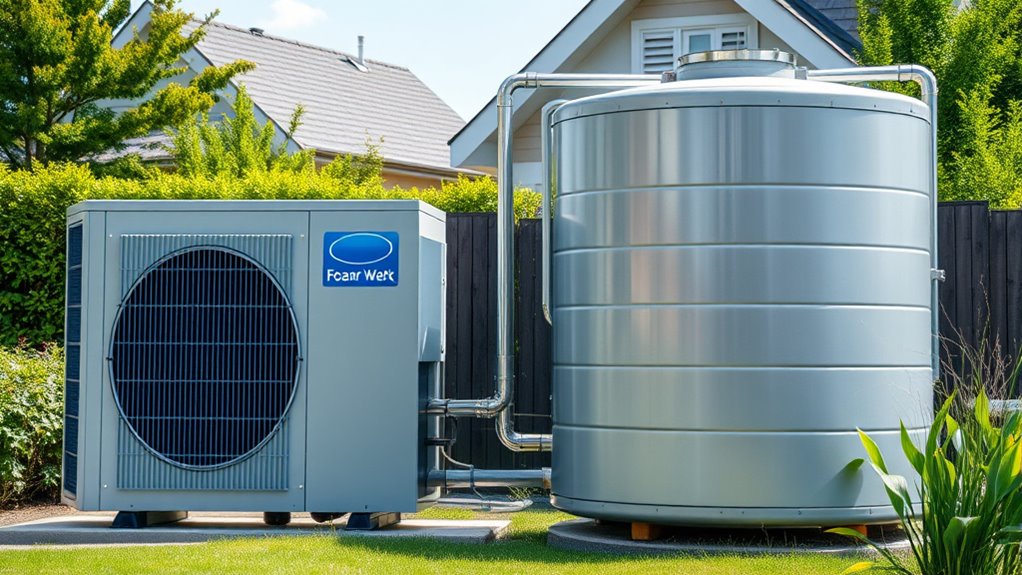
Combining heat pumps with thermal storage substantially boosts energy efficiency by allowing systems to operate more intelligently and flexibly. Thermal energy storage enables heat pumps to store excess thermal energy during low demand periods for later use, optimizing performance. This pairing reduces cycling frequency and peak demand, improving the coefficient of performance (COP). Using phase change materials (PCMs) enhances storage capacity and stability, making energy utilization more effective. Additionally, thermal storage supports higher renewable integration by capturing surplus solar or wind energy, decreasing reliance on fossil fuels. This integration also benefits from customizable storage solutions, allowing systems to be tailored to specific energy needs and consumption patterns. Proper system design is essential to maximize these benefits and ensure efficient operation. Moreover, understanding the variety of water parks and their features can help optimize leisure planning during seasonal peaks. Additionally, advances in smart grid technology can facilitate better coordination between thermal storage and energy supply, further enhancing overall system efficiency. Incorporating energy management systems can further optimize the operation and integration of thermal storage with heat pumps, leading to even greater efficiency. Overall, this combination maximizes energy efficiency and promotes smarter energy management.
Material Choices and Technologies in Thermal Storage Solutions
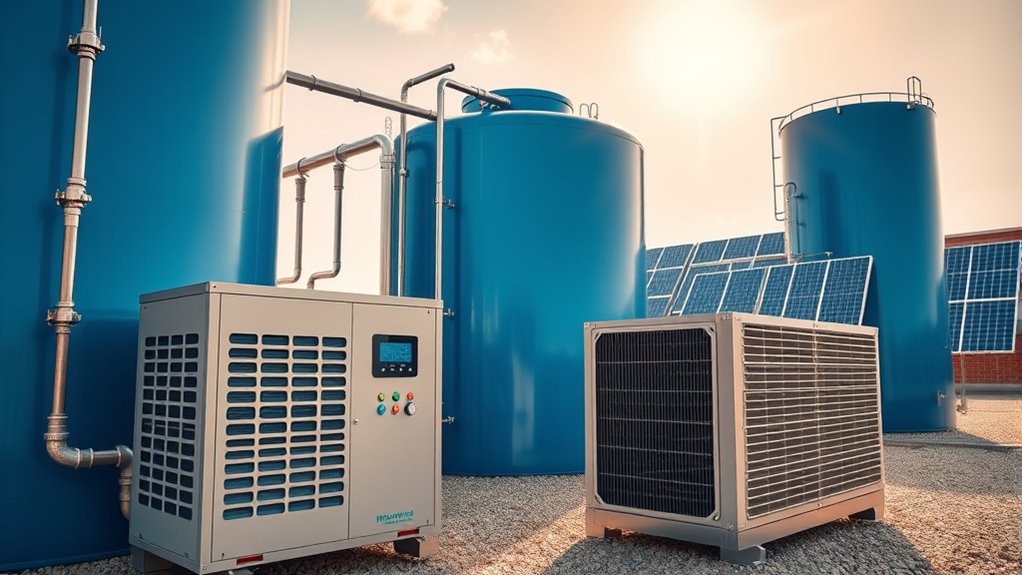
Material choices play a vital role in maximizing the effectiveness of thermal storage solutions within heat pump systems. Selecting the right phase change materials (PCMs) ensures high energy density, stability, and compatibility with refrigerants like R290. Advanced PCMs, such as those used in Sunamp’s Thermino ePlus units, offer low heat loss and rapid heating, boosting heat pump efficiency. Proper material selection balances thermal conductivity, melting point, and environmental safety, extending system longevity. Innovations focus on higher phase change enthalpy and cycle stability, enhancing performance. The table below highlights key material features:
| Material Type | Key Advantage | Application Focus |
|---|---|---|
| Organic PCMs | High latent heat, stability | Thermal storage with refrigerants |
| Inorganic PCMs | High thermal conductivity | Rapid heat transfer |
| Natural Refrigerants | Eco-friendly, efficient transfer | Sustainable heat pump systems |
| Composite Materials | Enhanced durability | Long-lasting thermal storage |
Additionally, ongoing research aims to develop more sustainable PCMs that reduce environmental impact while maintaining high performance standards. Improving material compatibility with refrigerants and system components is also a focus to ensure long-term operational reliability.
Policy Frameworks Supporting Heat Pump and Storage Integration
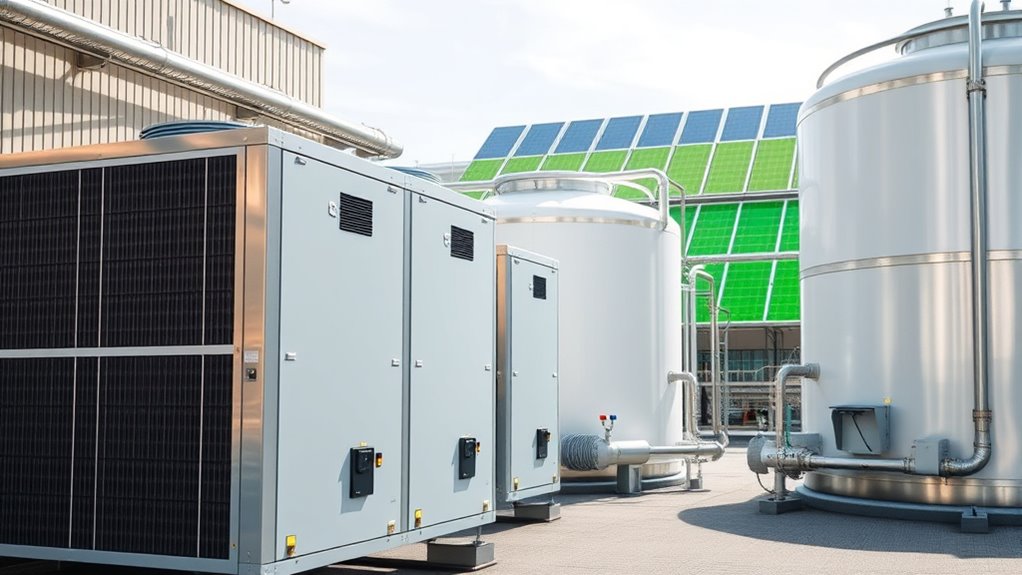
Policy frameworks play a pivotal role in accelerating the adoption and integration of heat pump and thermal storage systems. These policies, like the EU Directive 2018/2001 and Spain’s Royal Decree 178-2021, actively promote renewable heating through incentives and standards. They support expanding thermal energy storage and heat pumps to boost energy efficiency and grid stability. Regulatory measures also encourage standardization and certification of thermal storage technologies, making market entry smoother. National strategies emphasize research funding to foster innovative solutions for integrating thermal storage with heat pumps. This holistic approach ensures a conducive environment for scalable deployment, aligning technological advancement with climate goals. These policy frameworks are essential for transforming the energy landscape toward sustainable, renewable heating solutions. Additionally, fostering creative problem-solving in policy design can lead to more adaptive and innovative energy solutions in the face of evolving technological and environmental challenges. Recognizing the importance of public-private partnerships can further enhance the development and deployment of integrated thermal systems. Supporting policies that promote technological innovation can accelerate advancements in thermal storage and heat pump efficiency, ensuring long-term sustainability. Moreover, integrating insights from AI security can help develop smarter and more resilient energy management systems that optimize heat pump operation and storage. Furthermore, incorporating regulatory incentives can significantly stimulate market growth and technological adoption by reducing barriers for new thermal storage solutions.
Challenges and Limitations in Current Thermal Storage Technologies
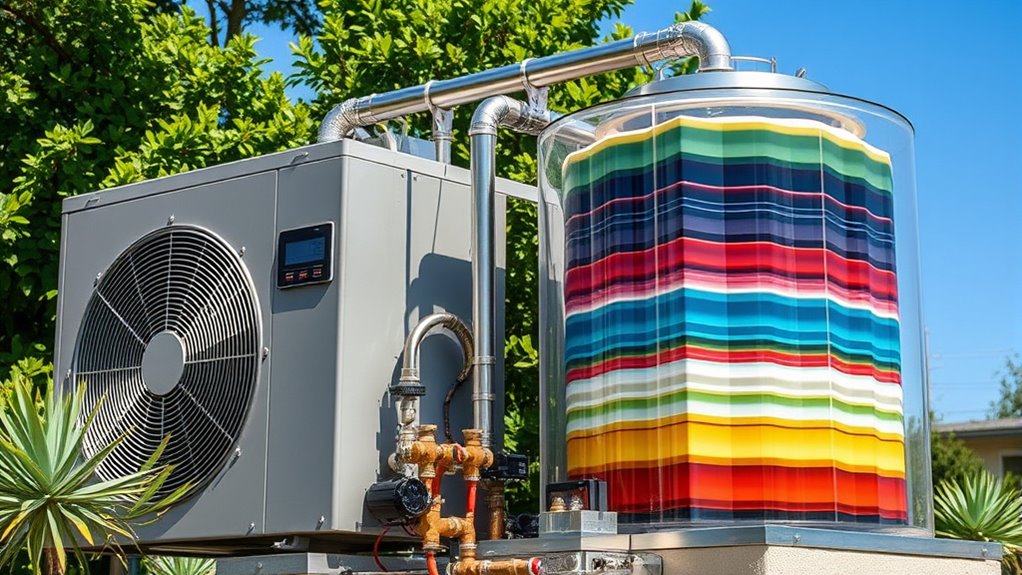
You’ll find that high system costs make widespread adoption difficult, especially for large-scale projects. Limited material durability also reduces the long-term reliability of many thermal storage options. These challenges hinder the development of more efficient and cost-effective solutions for thermal energy management. Additionally, cost considerations play a significant role in limiting the deployment of advanced thermal storage technologies. Implementing innovative materials and design approaches can help address some of these performance limitations.
High System Costs
High system costs present a significant barrier to the widespread adoption of thermal storage technologies, particularly PCM-based solutions. The high initial investment limits your ability to benefit from increased energy efficiency and effective heat pump integration. The elevated prices stem from manufacturing challenges and limited economies of scale, making advanced materials and components costly. Designing and sizing thermal storage systems for ideal performance adds complexity and expense, further increasing system costs. Additionally, the need for specialized materials raises installation and fabrication expenses. Although ongoing research aims to reduce these costs through material innovation and mass production, current expenses still hinder large-scale deployment.
- Limited economies of scale increase manufacturing costs
- Specialized components drive up installation expenses
- Complex system design impacts overall affordability
- High material costs challenge widespread adoption
Limited Material Durability
One of the main challenges facing current thermal storage technologies is the limited durability of the materials used, which can degrade over repeated thermal cycles. Phase change materials (PCMs) are popular for thermal storage, but they often suffer from material degradation like phase separation or leakage, reducing their effectiveness and lifespan. High thermal conductivity materials used in storage systems may experience material fatigue or corrosion, impairing heat transfer efficiency over time. Repeated freeze-thaw cycles in cold climates can physically deteriorate storage materials, decreasing energy capacity. This ongoing degradation hampers system reliability and limits widespread adoption of thermal storage solutions. To improve durability, ongoing research focuses on developing more stable, long-lasting materials that can withstand repeated thermal cycles without compromising heat transfer performance.
Case Studies Demonstrating Successful Integration Strategies
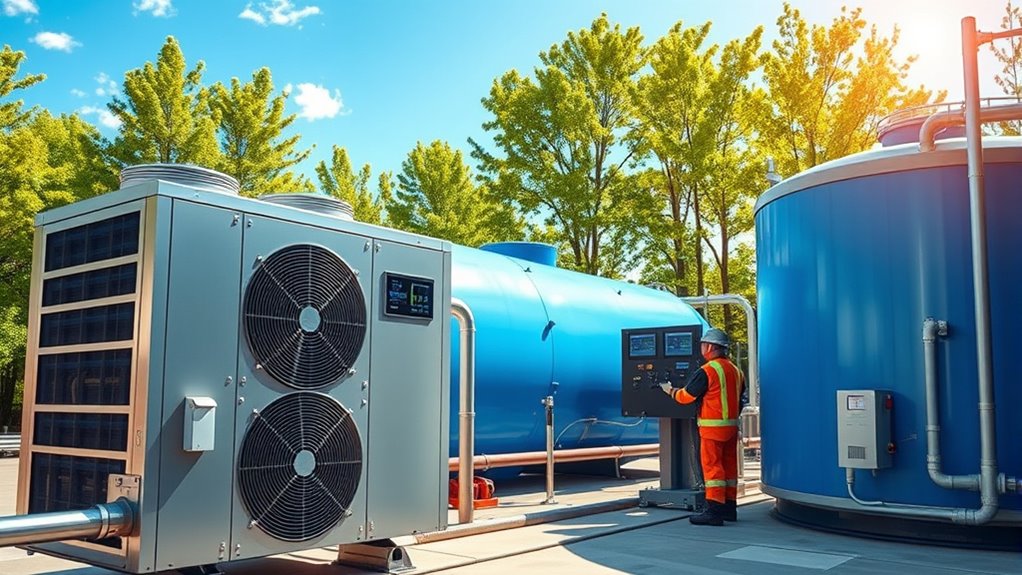
Case studies highlight how integrating phase change materials (PCMs) and thermal storage with heat pumps can considerably boost system efficiency and reliability. When you incorporate thermal energy storage, especially PCM-based systems, you can achieve up to 27% higher efficiency and reduce defrosting times in cold climates. Successful residential examples show continuous operation and energy savings exceeding 15%, often combining solar-assisted heat pumps with PCM storage. Industrial projects utilizing waste heat recovery and thermal storage demonstrate significant reductions in fossil fuel use and emissions. Pilot programs with reverse-cycle hot gas defrosting and TES strategies maintain ideal coil temperatures during extreme cold, enhancing performance. These case studies confirm that high-energy-density PCM storage requires less space and lowers maintenance compared to traditional sensible heat storage solutions.
- Integration of PCM with heat pump systems improves efficiency during cold weather.
- Waste heat recovery combined with thermal storage reduces fossil fuel dependency.
- TES strategies enable consistent operation in extreme climates.
- High-energy-density PCM systems require less space and maintenance.
Future Directions and Innovation Opportunities in Heat Pump and Thermal Storage Systems

Advancements in materials science and digital technologies are poised to revolutionize heat pump and thermal storage systems, making them more efficient, cost-effective, and adaptable. You’ll see improvements in thermal energy storage through advanced phase change materials and novel materials that boost storage density and reduce costs, enabling better system integration. Artificial intelligence and IoT will optimize operation, responsiveness, and control, maximizing efficiency. Policy incentives and subsidies will accelerate adoption of these combined systems, supporting large-scale deployment and grid stability. Emerging business models like virtual power plants and energy-sharing platforms will facilitate collective management of heat pumps and storage assets, enhancing sustainability. Ongoing research into hybrid electrochemical and thermal storage systems will further maximize energy flexibility, especially when integrated with renewable energy sources.
Frequently Asked Questions
How Do You Increase the Efficiency of a Heat Pump?
To boost your heat pump’s efficiency, you should optimize its size and choose refrigerants suited for low temperatures. Incorporate thermal storage like phase change materials to stabilize indoor temperatures and reduce cycling. Use advanced defrosting methods to minimize energy loss during cold weather. Connect renewable energy sources to lower grid reliance, and implement smart controls for real-time adjustments, ensuring your system operates at peak performance while consuming less energy.
Are Geothermal Heat Pumps Worth the Money?
You’re asking if geothermal heat pumps are worth the money, and honestly, it’s a smart investment that can pay off in the long run. These systems use the stable underground temperature to deliver high efficiency, saving you on energy costs over time. While the initial costs are high, incentives and lower operating expenses make them a win-win. If you plan to stay put, they’re definitely worth considering.
What Is the Most Efficient Way to Store Thermal Energy?
You’re asking about the most efficient way to store thermal energy. Using phase change materials (PCMs) is your best bet because they absorb and release latent heat during solid-liquid transitions, offering high energy density and stable temperatures. By integrating PCMs with your heating system, you can store excess energy, reduce energy costs, and improve overall efficiency, especially when paired with renewable sources like solar PV for ideal performance.
Why Don’t Contractors Like Heat Pumps?
You might notice contractors hesitate to recommend heat pumps because of their higher upfront costs and perceived complexity. They often lack confidence in installation and maintenance, especially in cold climates without advanced frost management. Uncertainty about proper sizing and design, along with market misconceptions and customer hesitations, contribute to their reluctance. As a result, many contractors prefer traditional systems they’re more familiar with, even if heat pumps could be a more efficient choice.
Conclusion
By integrating heat pumps with thermal storage, you’re not just embracing energy efficiency—you’re releasing a powerhouse of potential. Think of it as giving your system a secret weapon against rising energy costs and environmental impact. As technology advances and policies support innovation, now’s the time to harness this synergy. After all, isn’t it time you turned your energy use into a well-oiled machine that benefits both your wallet and the planet?


